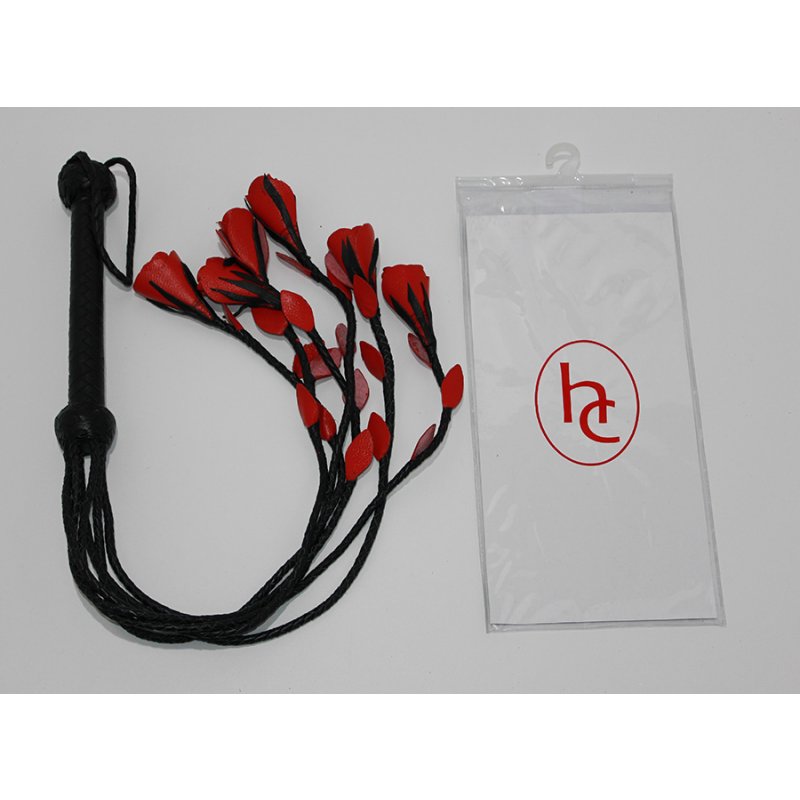The Cat O’Nine Tails commonly shortened to the cat is a type of multi-tailed whip that originated as an implement for severe physical punishment towards people who have committed crimes. Notably, the Cat O’ Nine Tails was used by the Royal Navy and Army of the United Kingdom, and also as a Judicial Punishment in Britain. The term Cat O’Nine Tails first appeared way back in 1695, however the design itself is much older and it is speculated that the name came from its “claws” ability to inflict several parallel wounds with one swift hit causing intense pain. It could inflict a lot of damage back in the olden day because it was made from 9 plaited thongs of cotton cord.
The Cat O’ Nine Tails is more commonly made from leather or a leather type of material It is generally still plaited into different patterns, with many different design and can include different numbers of tails. Regardless of how it is designed,
it will still inflict intense pain to the receiver
even when the person is not being whipped the open wounds will sting with the open air.
Back in the day when the navy used to use lashes from the Cat O’Nine Tails as a form of punishment, the punishment was performed on deck and the crew were summoned to witness the lashings with her expert whipping techniques. The severest type of flogging was given on or around the feet area and if your ship was docked at the time of the punishment, the lashings were divided up between the numbers of ships in port and the offender was flogged in front of each ship for the crew to watch. Often the person would faint during the lashing, but the punishment would continue until all the lashings were given. Later on in these instances, a surgeon was present for the flogging and would stop the punishment when he felt it necessary and in these circumstances it could take months for a prisoner to complete the number of lashings he was sentenced.

After a flogging with the Cat O’Nine Tails was completed the sailors lacerated back was rinsed in Brine or Saltwater regularly, it was thought to be a crude antiseptic which has since been proven to be untrue, however this practice even though extremely painful for the sailor, was not part of his punishment it was used to control infection. But this is where the term
“rubbing salt into the wound”
came from. The salt would remain in the sailors back until they had access to clean water. But back in those days, if you were working on a ship, the salt would rub against your skin naturally as it was carried in the air and the water around you. So your punishment went beyond the lashings but was also the after effect of the open wounds trying to heal themselves.
Now-a-days the Cat O’Nine Tails has become a highly popular choice in the world of BDSM, it is one of the sex toys everyone picks up a plays with when they walk into sex shops to see what it is like. The Cat O’ Nine Tails is still used as a punishment tool, however these days submissives or slaves are not whipped to within an inch of their life. When the whip is used during sex, it is in a safe and controlled environment but people who trust each other thoroughly. The person being whipped can use a safe word to let their dominatrix know if they feel unsafe or if the punishment has gotten to painful. There are many masochists who love a good flogging and whipping with the Cat O’ Nine Tails and choose to be bound and gagged. They choose to leave the decision up to the dominatrix on when to stop as they trust the person with their life. Some people have high pain tolerance levels combined with their body automatically producing pain killers or natural drugs to make the sensation feel pleasurable. Since it is pleasurable, they are able to gain sexual gratification from the experience of someone else inflicting pain onto their body.
Author: Pauline is a consultant from Oh Zone Adult Lifestyle Centres

Enter Andrew Pullen BDSM world of Fet Lifestyle, BDSM, and expert Shibari insights. Explore his descriptive and educational articles at Adultsmart.



In role play, the Cat o’ Nine Tails adds an electrifying element of dominance and submission. As wielder or recipient, its presence ignites anticipation, exploring power dynamics and trust. The crack of its lashes evokes a spectrum of sensations, from a gentle caress to a stinging reminder of control. Each strike becomes a dance of pleasure and pain, heightening senses and intensifying connection. It’s not merely about pain; it’s about surrendering to the moment, embracing vulnerability, and delving into the depths of desire. Through communication and consent, partners craft an exhilarating narrative, where the Cat o’ Nine Tails becomes a catalyst for exhilarating exploration.
Oh, the intriguing history of the CAT OF NINE TAILS! This fascinatingly eerie instrument has a history that dates back centuries, and it’s nothing short of riveting! This was not your everyday feline, no indeed! The CAT OF NINE TAILS, in fact, was a type of whip used predominantly in the British Royal Navy. Its unique design involved nine knotted cords that would whip out punishment to sailors who dared to defy orders or discipline.
The first known use of this terrifying tool was in the 17th century. It was used as a form of corporal punishment on naval ships, creating a chilling atmosphere of fear and obedience. The name ‘cat’ was derived from the ‘cat-like’ scratches that the whip left on the victims’ backs. The ‘nine tails’ referred to the nine individual thongs or cords on the whip. Each one was knotted three times – can you even imagine the pain!
But there’s more! Its use wasn’t limited to just naval discipline. The CAT OF NINE TAILS was also used in prisons and workhouses across Britain, Australia, and America. It was a symbol of authority, a tool of control and punishment. But don’t get too horrified – by the mid-19th century, its use started to decline due to rising humanitarian concerns.
The CAT OF NINE TAILS has since evolved from its dark past and has embedded itself into popular culture. It’s now often seen in films, literature, and even some video games as an icon of historical punishment. So there you have it! The CAT OF NINE TAILS is not just an artifact but a symbol representing an era marked by harsh discipline and punishment. Doesn’t history just make your spine tingle with excitement!
So I recently stumbled upon this article on the adultsmart blog about the history of the cat of nine tails whip, and I have to say, it was quite an interesting read. The author did a great job of delving into the origins of this controversial tool and providing some thought-provoking insights. Not only did they cover the historical significance of the cat of nine tails whip, but they also explored its various uses throughout different periods of time. I appreciated the way the writer presented the information in a casual and conversational tone, making it easy for readers to follow along and stay engaged. Overall, I found this article on the adultsmart blog to be both informative and entertaining, and I would definitely recommend giving it a read if you’re curious about the history of the cat of nine tails whip.
So, imagine this – I came across an article on the adultsmart blog about the fascinating history of the cat of nine tails whip. Let me tell you, it was a wild ride! The author really went deep into the origins of this quirky tool, and boy, did they have some hilarious insights. They didn’t just stop at the historical significance of the cat of nine tails whip, oh no! They took us on a journey through its different uses throughout history. I must say, the writer’s presentation was as funny as a stand-up comedy show. Trust me, you won’t want to miss it!